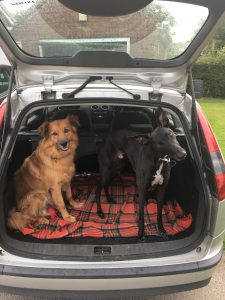Do You Baby Talk to Your Dog?
There has been lots of research on why people baby-talk to their dogs and, interestingly, how our pets respond to this. Read our Holidays4Dogs article to find out more.
When we baby talk to our dogs we tend to use a much higher pitch. We also often ask many more questions of our dogs, than we would our fellow human beings. A typical ‘conversation’ might go like this – “Who’s a good boy? You are, aren’t you? Yes, you are, you’re a very handsome boy”. Dog lovers everywhere will know exactly what we mean, I’m sure!
Telephone voice
This melodious outpouring of verbal affection is very similar to the way we talk to babies and, particularly in the case of women, this is based on an instinct to change the tone of voice when interacting with human babies.
We know our language and style of address changes, depending on who we are speaking to and the circumstances we are in. When chatting to friends, or family informally, we speak in a much different way than we do when we are communicating with a company representative, or an employer. We are all aware of the term ‘telephone voice’ to describe the more deliberate and formal way in which we engage with authorities, or people we have not met before.
Infant directed speech
When we talk to babies, we also use a particular tone of voice, pitched higher than our normal speaking voice. The style of baby talk flows along in a sort of sing-song manner, with lots of repetition. This is technically described as infant-directed speech.
We use this same style of speech with our pets too. Although women typically tend to use this tone of voice with babies and animals, all adults tend to talk in this way to children, whether they are parents, or not.
Even older children will engage in this sort of language when talking to babies, or children younger than themselves. Scientists believe this helps us to learn language. In addition, it is a way of communicating with others who cannot speak, by using light, repetitive tones.
Pet directed speech
Pet-directed speech is very similar. However, while infant-directed speech has a significant impact on human babies, (in that it teaches them language skills), what effect does this type of speech have on our pets?
In a study on the subject of pet directed speech, adult participants were given photographs of puppies and adult dogs. Their dialogue, while engaging with the images, was recorded. The tone and pitch of the voices was then analysed. It was found the participants engaged in pet-direct with all the images.
The recorded sounds were played back to assess the reactions of real dogs. From this, researchers were able to see that only the puppies were highly reactive to the higher-pitched baby talk. The adult dogs showed no difference in their reactions to normal speech, compared to pet-directed speech.
The findings were quite unexpected – strongly indicating that adult dogs don’t react to baby talk at all. However, researchers point out that puppies are much more receptive to high-pitched noise of any kind. As they age, they tend to react less to higher-pitched sounds.
However, the recordings played back to the dogs, were voices of unfamiliar people. This suggests older dogs react only to familiar voices, perhaps.
We know with our dogs, whether puppies or adults, tone of voice has an impact on their behaviour. Talking to a dog in a high-pitched, jolly manner is much more likely to catch a dog’s attention than ‘normal’ monotone speech.
Conclusion
Many people might think that dog-directed speech is utterly nonsensical. This is pretty much evidenced in the research. However, anecdotally, chatting and cooing to dogs, does seem to incite them to respond positively. Many pet dogs react excitedly, wagging their tails, or bringing toys when spoken to in up-beat tones.
Some may argue this particular study says more about human behaviour than dogs and – perhaps it does. However, I’m sure many dog owners can admit to baby talking to their four-legged pals and it seems to make us feel good – as well as our pets.




